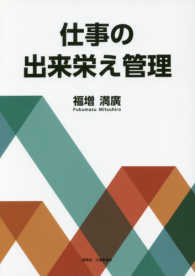Full Description
This volume concerns the structure and use of fixed expressions in a range of typologically, genetically and areally distinct languages. The chapters consider the use contexts of fixed expressions, at the same time taking seriously the need to account for their structural aspects. Formulaicity is taken here as a central feature of everyday language use, and fixed expressions as a basic utterance building resource for interaction. Our crosslinguistic investigation suggests that humans have the propensity to automatize ways to handle various discourse-level needs for specific sequential contexts by creating (semi-)fixed expressions based on frequent patterns. The chapters examine topics such as the degrees and types of fixedness, the emergence of fixed expressions, their connection to social action, the new understanding of traditional linguistic categories in light of fixedness, crosslinguistic variation in types of fixed expressions, as well as their non-verbal aspects. The volume situates the notion of 'units' of language at the intersection of interaction and formal structure as part of a larger effort to replace rule-based conceptions of language with a more dynamic, realistic and pragmatically based model of language. The articles are based on naturally occurring data, mostly everyday conversation, in English, Estonian, Finnish, Japanese, and Mandarin, with some crosslinguistic comparison.







